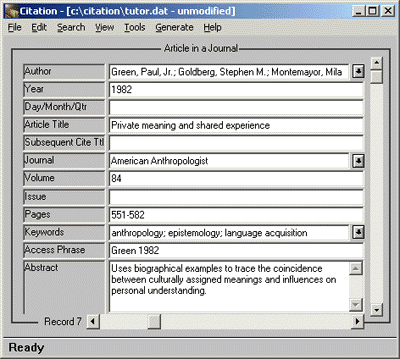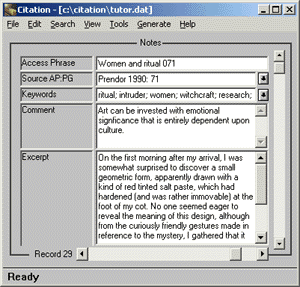





|

|
|
General information on data entry forms
The data entry forms in Citation make entering bibliographic easy and efficient.
Here's how it works. Right now, you enter bibliographic data as formatted citations, in a "sentence-like" form, that follows a particular set of guidelines:
As you are writing these citations, you have to be careful to follow the rules in your style manual for presenting the author names, adding print attributes for titles, inserting punctuation and spaces, and sequencing information. Then, if you need to change the style of the citations for another publisher, you will need to retype the citation, search for any missing information -- and proofread everything again -- a time consuming task that doesn't contribute much substance to your research. A time consuming task Citation takes care of for you.
|
|
Citation saves you time by letting you enter bibliographic information in a way that makes a lot more
sense: you enter information into a form for the type of work you are citing, using only
one set of guidelines. It's an easy and efficient way to record bibliographic information on your resources. You can enter keywords and abstracts, along with other information about the work. You'll be able to enter the full name of the author, so you won't have to go looking for it later, and let Citation truncate the names to initials for you, add the punctuation, put information in the right sequence, and insert the proper print attributes.
Citation formats the bibliographic information in a "Preview box" as it is typed into the record.
|   |
|
Fields on the forms help you enter all the information you need for proper citations
One of the most common frustrations we encounter in research writing is keeping careful records
on source works. Often, we find that in the notes we kept during the research process, critical
pieces of information were not written down - so we have to return to the library, find the work
again, and record the publisher's name, the author's full name, etc.
Citation will help you make the time you spend entering bibliographic information more efficient. Because Citation provides you with forms specifically tailored for different types of source works, the fields on the form provide you with prompts that remind you to include certain critical pieces of information.
|
|
Entering all the pieces of information for a book that is part of a multivolume set, for instance, is easy, using Citation's forms.
Citation provides you with a wide range of forms, with the appropriate fields, for different types of resource works. Most types of resource works, of course, are quite easy to enter records for, using Citation's forms. Sometimes, though, we encounter a source work that is not commonly used - a treaty, for instance, or perhaps a preface to a book. For these types of works, ordinarily, you would need to consult your styleguide. Citation provides comprehensive searchable style guides, detailing the forms to use for almost any type of source work, and illustrating how the information needs to be entered into the form.
| 
|

| 
|
|
You can include your comments on the excerpt in the record, summarizing the significance of the
excerpt to your own research.
If you also include keywords, you will be able to easily group all your notes and sources on a topic for review before you begin writing. There are several other note forms available, as well, for different type of projects, including interview transcripts. In fact, Citation provides you with forms for just about any kind of resource work or note you might want to add to your database.
|
Ó
2003 Oberon/askSam
Citation is a registered trademark of Oberon Development.